Introduction
In December 2017, the then Commander United States Central Command (USCENTCOM), General (now-retired) Joseph Votel, published his 2018 Commander’s Reading List. This list is an insight into an experienced senior leader’s thinking and intent. With only 12 titles, it is a relatively short list divided into five areas of study: leadership; managing complexity; strategy; understanding the CENTCOM area of responsibility; and, innovation.
The reading list was a beginning, not an end. General Votel’s intent for his staff was that we read, review, discuss and learn from each of the reading list books. With advanced warning before each discussion, the CENTCOM staff could focus on the topic and read with purpose. This format, a short reading list with follow-up collegiate discussions, enabled some of the most challenging and insightful professional military education experienced by this author.
This review essay, Part 2, enables observations on understanding the CENTCOM area of responsibility and innovation from General Votel’s 2018 Commander’s Reading List to provide options for readers should they seek to study a selection of these titles. In addition, this essay includes four additional books not originally selected by General Votel, but which complement his original intent.
Understanding the CENTCOM Area of Responsibility
The Lemon Tree by Sandy Tolan
- Juxtaposes, joins and interweaves histories of two families, and protagonists Bashir and Dalia, and places them in the larger context of Palestinian and Israeli relations since 1936.
- Builds an understanding of the reality and history of two peoples on the same land.

The Lemon Tree by Sandy Tolan, 2008.
The Silk Roads by Peter Frankopan
- Western education biases history towards the sequence of ancient Greece, Rome, Christian Europe, the Renaissance, the Enlightenment, political democracy, the industrial revolution and beyond.
- However, France, Germany, Austria, Spain, Portugal and England ‘had nothing to do with Athens and the world of the ancient Greeks and were largely peripheral in the history of Rome from its earliest days to its demise’. Which means that the Renaissance, 1300-1600, was not a ‘re-birth’ but a Naissance ‘a birth’. During this period, for the first time in history, Europe lay at the heart of the world.
- The Silk Roads – the bridge between the east and west – are the very crossroads of civilisation, including the birth places of Judaism, Christianity, Islam, Buddhism and Hinduism as well as philosophy, sciences and languages.
- Frankopan argues that the ‘heart of the world’ is moving away from the West back to the nations of the Silk Roads.

The Silk Roads by Peter Frankopan, 2016.
The Twilight War by David Crist
- Daily, 20 per cent of the World’s oil flows through the Strait of Hormuz linking the Persian, or Arabian, Gulf with global trade. Since 1949, the US Navy has patrolled this waterway.
- Dr Crist’s father, General George Crist, United States Maine Corps, was the second Commander USCENTCOM, 1985-1988.
- There is a gray-zone in the United States and Iran relationship. Without diplomatic ties, the US and Iran have been suspended between war and peace for over forty years. This gray-zone is dangerous.
- Some key elements influencing today’s US-Iran gray-zone relationship:
- The US imposed the unpopular dictator on Iran, the Shah, in a 1953 coup.
- Following Britain’s decision in 1968 to ‘end 140 years of colonial occupation of the Persian Gulf’, President Richard Nixon developed the ‘twin pillars strategy’. This strategy relied upon ‘two staunchly anti-communist powers in the region: Iran and Saudi Arabia’.
- The Iranian Islamic Republic replaced the Shah in 1979 with Ayatollah Khomeini, at which point the US and Iran turned from allies to adversaries.
- On 04 November 1979, Iranian students seized the US Embassy in Tehran and detained more than 50 Americans, ranging from the Chargé d’Affaires to the most junior members of the staff, as hostages. The Iranians held the American diplomats hostage for 444 days.
- In January 1980, President Jimmy Carter defined America’s relationship with the Middle East, stating ‘an assault by any outside force to gain control of the Persian Gulf region will be regarded as an assault on the vital interests of the United States of America… and will be repelled by any means necessary, including military force’
- On 01 March 1980, US Readiness Command, the antecedent of USCENTCOM, was established in Tampa, Florida, for ‘contingencies threatening American interests anywhere in the world’, including the Persian Gulf and the Middle East. USCENTCOM was established in 1983.
- The Iran-Iraq War, September 1980 – August 1988, when the US supported Iraq, ‘forced a transformation of the [Iranian] Revolutionary Guard… embroiled in a major conventional war… their ranks swelled to more than 250,000 front-line soldiers’. From this war, the Revolutionary Guard became and remain the pre-eminent military, economic and political force in Iran.
- The Revolutionary Guard enabled attacks on US interests in Lebanon including: killing 241 US Marines in Beirut, October 1983; bombing the American Embassy, Beirut, September 1984; kidnaping the CIA Station Chief, Beirut, March 1984; and, hijacking a TWA Boeing 727, en-route from Athens to Rome, June 1985.
- In 1985-1987, through Iran-Contra arrangements, the US shipped advanced weapons to Iran as ransom payment for the release of hostages in Lebanon.
- Iran Air flight 655 was shot down by the missile cruiser USS Vincennes on 03 July 1988, over the Strait of Hormuz, killing all 290 people on board. The passenger plane, which was in Iranian airspace, had been incorrectly identified as a fighter jet.
- In January 2002, President George W. Bush identified North Korea, Iraq and Iran as the ‘axis of evil’.
- The Iran problem has been, and remains, an enduring aspect of American foreign policy.
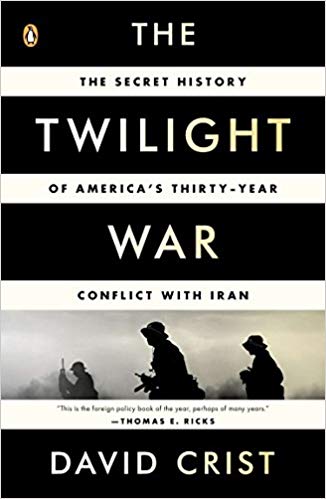
The Twilight War by David Crist, 2013.
Prisoners of Geography by Tim Marshall
- Tim Marshall’s ten maps include: Russia; China; United States; Western Europe; Africa; Middle East; India and Pakistan; Korea and Japan; Latin American; and, the Arctic.
- Individual leaders, ideas and technology all play a role in shaping events, but they are temporary. Geography is permanent.
- The very name 'Middle East' is based on Europe’s view of the world. The colonial powers, including the Anglo-French Sykes-Picot agreement of 1916, used ink to draw lines that bore no relation to the geographical, ethnic or religious realities of the region. Today, in the Middle East, these boundaries are being redrawn in blood.
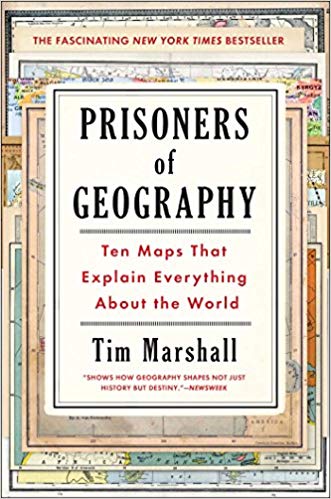
Prisoners of Geography by Tim Marshall, 2015.
The Unravelling by Emma Sky
- Nothing that happened in Iraq after the overthrow of Saddam Hussein in 2003 was preordained. And there was nothing inevitable about the way the story unfolded.
- Emma Sky spent a decade in Iraq seconded from the British Foreign and Commonwealth Office as a political adviser to US leaders. She originally served in Kirkuk with the then-Colonel Bill Mayville (retired Lieutenant General), Commander 173rd Airborne Brigade, June 2003-June 2004, then with General Ray Odierno in Baghdad, January-December 2007 and again from May 2008-September 2010.
- The Unravelling describes the challenges of nation building and how the overthrow of an authoritarian regime can lead to state collapse and conflict. It reminds us of the limitations of external actors in foreign lands, but also where we can have influence.
- Sky reflects on her role as a political adviser, ‘I had faced moral ambiguities on a daily basis. I was not a critic on the side, but a player in the arena, with all the challenges and compromises that entailed…[and despite the experience being] so hard and extreme, [Sky] was only too conscious of how much more needed to be done’.
- On US military efforts in Iraq, Sky observes, ‘the US military strove to embody the ideals and values of the Founding Fathers that America should be a place for different peoples regardless of background and creed… [Sky] felt that everything in [her] life had been in preparation for this work in Iraq’. US leaders had allowed Sky to be herself, a ‘non-compliant force’, and had given her the platform to reach her personal and professional potential.
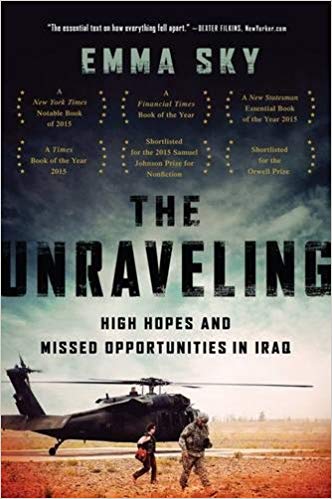
The Unravelling by Emma Sky, 2016.
Innovation
Thinking, Fast and Slow by Daniel Kahneman
- This is a book about judgement and choice. It is easier to recognise the mistakes of others than to recognise our own. We can benefit from the informed opinion of others.
- Kahneman seeks to enrich the vocabulary people use when they talk about the judgements and choices of others or viability of new policies or appropriateness of financial decisions.
- Kahneman seeks for us to learn to recognise situations in which mistakes are likely and try harder to avoid significant mistakes when the stakes are high.
- Systematic errors are known as biases and they recur predictably in particular circumstances. Overconfidence is fed by the illusory certainty of hindsight.
- System 1 – Fast thinking or automatic operations: is more influential and seemingly coherent than your experience tells you, including both variants of intuitive thought – the expert and the heuristic – as well as the entirely automatic mental activities of perception and memory. System 1 is the experiencing-self, which does our living:
- Expert intuition, strikes us as magical – but it is not. Intuition is nothing more and nothing less than recognition resulting from thousands of hours of practice, for example as a parent, leader, teacher, doctor, lawyer, engineer or military professional.
- Intuitive heuristics: when faced with a difficult question, we often answer the easier one instead, without noticing the substitution.
- For example, employing System 1, humans can think associatively, metaphorically and causally but statistics require ‘thinking about many things at once, which is something that System 1 is not designed to do’. System 1 has little understanding of logic and statistics
- System 1 actions are fast, automatic and learned:
- Judging distance
- Orient to sound
- Complete the phrase ‘bread and…’
- Involuntarily make a ‘disgust’ face
- Detect hostility
- Read advertising
- Drive on an empty road
- Biased to believe and confirm
- System 2 – Slow thinking or controlled operations: if a spontaneous search for an intuitive solution fails, we often find ourselves switching to a slower, more deliberate, effortful and orderly form of thinking. System 2 thinking is often associated with the subjective experience of agency (performance of intentional actions), choice and concentration. The often-used phrase “pay attention” is apt: we all have a limited budget of attention, if we try to go beyond our budget – we will fail. We can do several things at once, but only if they are easy and undemanding. System 2 is the remembering-self, taking over and making choices when things get difficult.
- System 2 actions, require attention and are disrupted when attention is drawn away:
- Brace for a starter gun
- Focus attention on a single voice in a crowded room
- Look for a particular person
- Search memory to identify a surprise sound
- Maintain a faster walking speed than is natural for you
- Monitor the appropriateness of your behaviour in a social situation
- Maintain control keeping you polite when you are angry
- Park in a narrow space
- Enable self-reflection and self-criticism
- When deliberately employed, System 2 enables the ‘framing of the problem to be solved, the collection of relevant information leading to a decision, reflection and review’.
- System 2 actions, require attention and are disrupted when attention is drawn away:
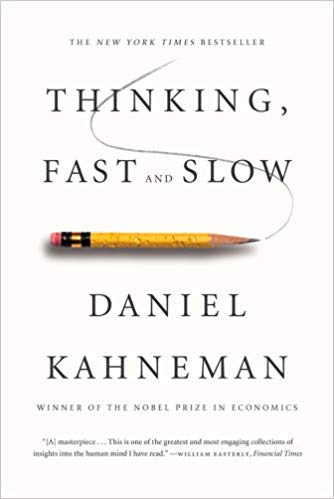
Thinking, Fast and Slow by Daniel Kahneman, 2013.
On Flexibility by Mier Finkel
- Finkel’s work seeks to answer the question: ‘how do armies cope with technological and doctrinal surprises that render them vulnerable to unexpected weapons systems and/or combat doctrines?’
- Finkel’s answer is to ‘counter force planning concepts overly dependent on predictions and intelligence reports that try too hard to predict the future battlefield… through the ability of a force to recuperate swiftly from initial surprise’.
- The book examines conceptual limitations on our ability to recuperate swiftly from surprise include group-think, large-bureaucracies, inter-branch, inter-service and inter-agency frictions, and failure to learn from mistakes,
- Finkel argues that forces recovering quickly from technological and doctrinal surprises employ a variety of abilities under the rubric of flexibility, including agile employment, response skills and reaction time of:
- doctrine
- cognition
- command
- organisation
- technology
- Flexibility-based Force Planning envisions ‘transferring the solution onto the battlefield in real time in order to overcome peacetime obstacles’ through four mutually-dependent strata or layers:
- First, conceptual and doctrinal: encourage open-minded ideas that challenge official doctrine presenting a balanced view of all forms of war.
- Second, organisational and technological: obtain balance among basic military capabilities (attack and defence; firepower and manoeuvre; assault and logistics requirements). No weapon is immune to counter-measures or defeat. Therefore, of paramount importance for organisations and technology is redundancy, versatility, interoperability and changeability.
- Third, command and cognitive skills: mental flexibility is an acquired trait of commanders who have rehearsed, learned and operated in environments encouraging and enabling questioning, creativity, seizing the initiative and generating original solutions.
- Fourth, fast learning and rapid circulation of lessons: enabling fast learning from mistakes and rapid circulation of lessons so that an entire military system, include weapon designers and manufacturers, is updated on surprises and informed of options for solutions.
- Finkel examines seven historical test cases that lend empirical support to Flexibility-based Force Planning and four mutually-dependent strata:
- German recovery from surprise of British airborne-chaff deployment, 1943
- German recovery from the surprise of Soviet T-34 deployment, 1941
- Israel recovery from the surprise of Egyptian Sagger anti-tank missile deployment, 1973
- Israel Air Force recovery from the surprise of Arab anti-aircraft missile deployment, 1973
- Slow British recovery from German armour and anti-tank tactics in the Western Desert, from the first encounter with Rommel, late-March 1941, until the second battle of El Alamein, October-November 1942
- Slow Soviet recovery from the surprise of low-intensity conflict in Afghanistan, December 1979 – February 1989
- French failure to recover from the surprise of German blitzkrieg, 1940

On Flexibility by Mier Finkel, 2011.[3]
Antifragile by Nassim Nicholas Taleb
- Antifragility is ‘beyond resilience or robustness’. Resilience or robustness are neither harmed nor helped by volatility and disorder. The resilient resists shocks and stays the same; the antifragile gets better.
- Antifragile is behind ‘everything that has changed with time: evolution; culture; ideas; revolutions; political systems; technological innovation; cultural and economic success; good recipes; the rises of cities, cultures, legal systems, equatorial forests, bacterial resistance…even our own existence as a species on this planet’.
- Consider a Triad of Fragile-Robust-Antifragile, where fragile seeks tranquillity, antifragile grows from disorder and robust ‘doesn’t care too much’. This Triad has practical planning implications for ‘when you discuss an item or a policy, the task is to find in which category of the Triad one should put it and what to do in order to improve its condition’. This process and approach is known as the 'barbell' strategy.
- The antifragile ‘loves randomness and uncertainty’ and ‘loves errors’ providing that ‘harm from errors is less than the benefits’. Antifragility means that ‘we are largely better at doing, usually through heuristics (rules-of -thumb), than we are at thinking’.
- Antifragile is composed of seven books and a notes section, key themes include:
- Book 1: Antifragile
- Book 2: Modernity – ‘we are fragilising social and economic systems by denying them stressors and randomness, putting them in the Procrustean bed of cushy and comfortable – but ultimately harmful – modernity’. Procrustes was an inn-keeper in Greek mythology who, in order to make the travellers fit in his bed, cut the limbs off those who were too tall and stretched those who were too short. But he had the bed fitting the visitor with total perfection.
- Book 3: Nonpredictive world view
- Book 4: Optionality, technology and intelligence
- America’s asset is, simply, risk taking and the use of optionality. This remarkable ability to engage in rational forms of trial and error, with no comparative shame in failing, starting again, and repeating failure.
- The fragile has no option. But the antifragile needs to select what’s best – the best option.
- We don’t put theories into practice. We create theories from practice.
- Book 5: Nonlinear – if for a given variation you have more upside than downside, then the curve is convex (curving upwards), and the opposite for concave (curving downwards). Convex likes volatility. If you can earn more than you lose from fluctuations, you want a lot of fluctuations.
- Book 6: Via Negativa – introducing the notion of convexity effects
- Book 7: Ethics
- the worst problem of modernity lies in the malignant transfer of fragility and antifragility from one party to the other, with one getting the benefits, the other one (unwittingly) getting the harm, with some transfer facilitated by the growing wedge between the ethical and the legal.
- Consider a barbell, a Triad of Fragile-Robust-Antifragile, translated as:
- No Skin in the Game: keeps upside, transfers downside to others.
- Skin in the Game: keeps own downside, takes own risk.
- Skin in the Game for the sake of others or Soul in the Game: takes the downside on behalf of others or universal values.
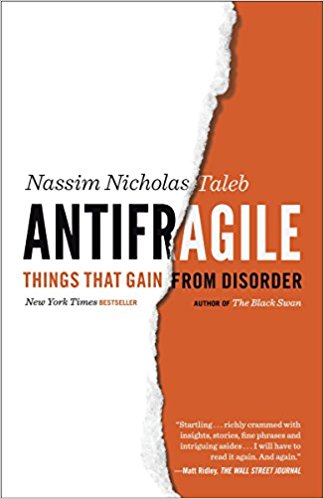
Antifragile by Nassim Nicholas Taleb, 2014.[4]
Conclusion
This review essay, Part 2, provides observations on books related to CENTCOM area of responsibility and innovation from General Votel’s 2018 Commander’s Reading List, with four additional titles, to provide options for readers should they seek to study a selection of these titles. As noted, this short reading list with follow-up collegiate discussions, enabled some of the most challenging and insightful professional military education experienced by this author.










Thanks for the booklist, reviews and encouragement to adopt a similar format for PME.
There are a few excellent looking books here on specific contexts.
But to begin with I am going to look out for Kahneman, Thinking, Fast and Slow for its insights into innovation and out-of-the-box thinking.
Regards